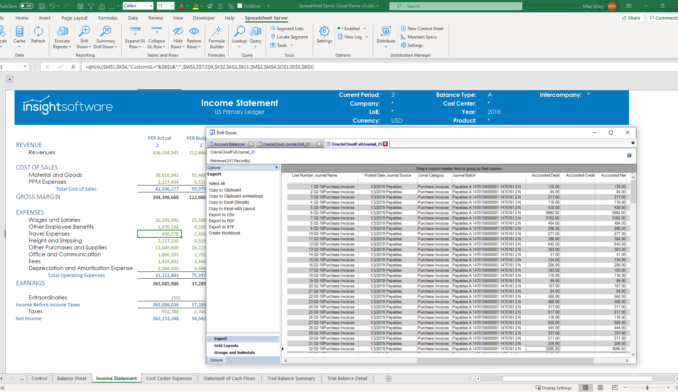Five Things Finance Teams Wish ERP Vendors Knew

For years, we have heard a common set of complaints from CFOs frustrated with the reports they get from their Enterprise resource planning (ERP) systems. They eventually come to insightsoftware because they’re looking for better, faster, more accurate ways of turning their vital business information into meaningful insights to help business leaders make important decisions.
Finance teams experience frequent roadblocks in getting the information they need to reconcile accounts, close the books, or simply to perform some ad hoc analysis on their ERP data.
Why is it that getting useful information out of your ERP system is so hard? Unfortunately, reporting is one of those functional areas that ERP vendors typically treat as an afterthought. They know that they need some baseline functionality there, but it virtually never comes up in the sales cycle as a competitive differentiator, so they don’t invest much in it. Instead, buyers are usually focused on business critical requirements such as the way the ERP tracks and manages inventory, how it records and allocates billable time to customer projects, or whether the system supports certain manufacturing capabilities.
It’s pretty rare that a potential ERP buyer asks detailed questions about reporting capabilities. After all, it seems safe to assume that if an ERP system tracks all of the most important information in your business, you should be able to get that information back out of the software, right? Of course the answer is “yes,” but what most people don’t know is that there should be a big asterisk next to that answer, informing the buyer that it might be a bit more challenging than they assume.
So what do finance teams wish their ERP vendors knew about the challenges of reporting, planning, and analysis? Here’s the list of the top five, based on our conversations with customers who have turned to insightsoftware for help.
Challenge 1. Plain-Vanilla Reports Don’t Work Well for Most of Us
It’s often the case that one-size-fits-all solutions simply don’t fit anyone very well. Fortunately, ERP systems have evolved to the point that customization of inquiry and data input screens to fit the individual needs of each business is possible. In fact, you can also make those kinds of tweaks for individual users as well, bringing a level of personalization to the software that can streamline workflows and simplify a person’s job considerably.
Unfortunately, that kind of simple, intuitive customization and personalization usually doesn’t extend to ERP system reports. Changing column layouts, adding subtotals, renaming fields, or adding a new field to a report may all require hours of additional work from IT experts who have the specialized skills needed to do the job. When the IT department has a backlog of service requests, that can mean days or weeks of waiting for even small changes to your ERP reports.
Challenge 2. Ad Hoc Analysis is a Huge Part of What Finance Teams Do
You likely use some of your organization’s ERP reports over and over again. They provide important information that helps guide day-to-day decisions. The finance team typically has much more complex needs, though. Ad hoc analysis comprises a major part of what they do.
The need for ad hoc analysis might arise from an inquiry from the CEO or CFO,who might say something such as “Show me an analysis of occupancy expenses over the past three years, and highlight any variances from budget that exceed 10%.” In some cases, it is driven by compliance requirements, such as providing a detailed schedule of equipment purchases for tax reporting purposes.
Perhaps even more importantly, financial analysis provides critical input to some of the biggest decisions facing a business’ management team. Business managers struggle with a long list of “what if” questions. Routinely, finance teams around the world are called upon to build out scenario models that can help management better understand the road ahead, including best case and worst case outlooks, projected cash flow, and more.
Unfortunately, ERP reporting tools simply aren’t designed for rapid, flexible analysis. A common approach among many finance teams is to export data from ERP, import it into a spreadsheet, and combine it with relevant data from other sources if necessary. That’s slow, tedious, and error-prone.
Challenge 3. Finance Teams Don’t Want to Spend Their Time Becoming Database Experts
Virtually all ERP systems store their data in a relational database—that is, in a large collection of interrelated database tables. Those tables often have somewhat cryptic names, and they’re populated with individual fields and values that can be extraordinarily difficult to decipher.
Unfortunately, writing or modifying reports with most ERP systems rests upon a user’s capacity to get to know the contents of that database at an exceptional level of detail. In many cases, it means being able to translate between a numeric value in the database (e.g. 1, 2, or 3) and what that value actually means in a business context (e.g. whether the record in question is an order, an invoice, or a credit memo). That doesn’t even begin to touch on the complex relationships between multiple tables, which you must logically associated with one another during the report design process.
Getting information out of your ERP system simply shouldn’t require this level of detailed database knowledge.
Challenge 4. When It’s Crunch Time, Export/Import/Copy/Paste Just Isn’t Very Helpful
When you need to pull information together quickly, such as at the end of the month, the tedious process of assembling your own custom reports using a spreadsheet simply takes too much time. Most finance teams have a great deal of work to get through, and their goal is to get financial statements to management within a very tight deadline. Many of the most common period-end activities such as account reconciliations are heavily dependent on worksheets and ad hoc analysis.
If your finance team must export data from ERP and paste it into a spreadsheet every month, they’re doing the same work over and over again, wasting valuable time. To make matters worse, these kinds of manual processes often lead to errors. If this month’s data contains an extra row that wasn’t in last month’s report, it can easily throw off a formula and render the entire report inaccurate.
Because you’re copying static information from your ERP system, an update to the data in ERP makes it necessary to do all that copying and pasting again, just to update the report. If the finance team lacks the ability to create flexible reports and update them in real time, the period-end closing process can feel like an endless cycle of copying, pasting, and re-creating those reports virtually from scratch.
Challenge 5. Our Reports Need to Include Non-ERP Data Too
By their very nature, ERP systems aim to be comprehensive. They’re designed to bring all of an organization’s mission-critical information under one roof. While they generally do a good job of that, ERP vendors should keep in mind that most businesses must still run other kinds of software systems for one reason or another.
CRM is a common example. Although the finance department generally has relatively little to do with customer relationship management, there are legitimate reasons for including CRM information in some of the reports that finance develops. A rolling analysis of historical sales trends alongside likely deals recorded in the CRM sales pipeline, for example, can provide the executive suite with a view of the near-term outlook in the context of recent sales performance.
Similarly, many organizations operate specialized billing software designed specifically for their business, and you may need to combine that with ERP data to generate meaningful, holistic reports for the business.
Unfortunately, the design of most ERP reporting tools assumes that all of the important information is locked up in the ERP system. That limited perspective leads to information silos. For a finance team that wants to unify information from multiple systems, it just makes the whole process more difficult.
Purpose-Built Reporting Makes the Job Easier
Fortunately, there are powerful, purpose-built reporting tools that address every one of the challenges outlined. As the global leader in this space, insightsoftware offers a range of purpose-built solutions that integrate with over 140 different ERP systems, providing real-time access to your critical business data and the flexibility to design or modify reports without specialized IT training.
With reporting and planning tools from insightsoftware, you don’t need to be a database expert. We make it simple and intuitive to get the information you need. Our products inherit the user-level security restrictions that you set in your ERP system, so you know that your confidential information remains secure. With these tools, finance teams can reduce their dependence on the IT department and improve the results they get from reporting and analytics.











